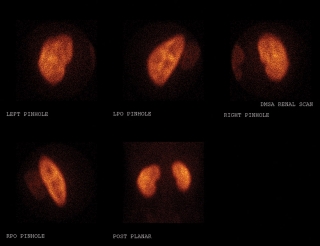DMSA Scan
What is a DMSA scan?
A DMSA scan evaluates the size, shape and position of the kidneys. It is also used to detect any scarring in the kidneys caused by frequent infections.
 We do the test by giving your child an intravenous radiopharmaceutical. This "tracer" is medicine combined with a small amount of radioactive material. It travels to the area of your child we need to see and is detected and imaged by a gamma camera.
We do the test by giving your child an intravenous radiopharmaceutical. This "tracer" is medicine combined with a small amount of radioactive material. It travels to the area of your child we need to see and is detected and imaged by a gamma camera.
Radiopharmaceuticals are carefully tested. The risk of side effects is extremely small. Most radiopharmaceuticals used in nuclear medicine studies give less radiation exposure than a day at the beach.
What should you do prior to the exam?
- Your child will need to hold still during the hour-long test. You may want to practice with your child.
- If your child requires sedation you will receive additional instructions to follow.
- Dress your child comfortably, in clothes that are easily removed. Your child may be given a gown to change into for the procedure.
- We have a large variety of video entertainment to choose from, however, your child can also bring along a favorite movie to watch during the exam.
- You may want to bring a snack or drink for your child to have after the exam.
Note: Parents will be allowed to accompany their child into the exam room. It may be helpful to make other arrangements for siblings.
What should you expect during the exam?
- A technologist or nurse will place an IV in your child’s arm, hand or foot. Your child may feel a small pinch.
- The technologist will ask why the DMSA scan is being done and will explain the study to you and your child.
- The technologist will inject the tracer through the IV line.
- You and your child will take a two- to four-hour break. You may leave the Nuclear Medicine department if you wish. The technologist will tell you what time you need to return to the department for the imaging portion of the test.
- When you return, your child will be placed on the table, stomach down, with the camera above. Five pictures will be taken, lasting 10 minutes each. Your child must lie absolutely still or images may be unreadable.
- The nuclear medicine physician may want to take more images after viewing the initial ones.
- Young patients and those who are unable to hold still may be sedated for the test.
If you’d like, our child life specialists will help you prepare and support your child during the procedure. We can also arrange to have a child life specialist at your child's appointment to explain the procedure in developmentally appropriate ways and to help your child better cope with the stress of the hospital experience.
What should you do after the exam?
There are no special instructions for your child to follow when the procedure is complete.
Test results
The images from your child's exam are interpreted on the same day and a report is sent to your physician's office.
Your physician may call 215-590-2584 with questions about the exam.
Here is an example of what your child's scan may look like.